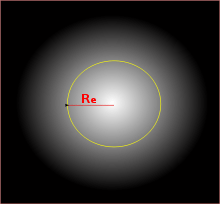Effective radius

Half light radius Re encloses half of the total light emitted by an object
The effective radius ( ) of a galaxy is the radius at which half of the total light of the system is emitted.[1][2] This assumes the galaxy has either intrinsic spherical symmetry or is at least circularly symmetric as viewed in the plane of the sky. Alternatively, a half-light contour, or isophote, may be used for spherically and circularly asymmetric objects.
) of a galaxy is the radius at which half of the total light of the system is emitted.[1][2] This assumes the galaxy has either intrinsic spherical symmetry or is at least circularly symmetric as viewed in the plane of the sky. Alternatively, a half-light contour, or isophote, may be used for spherically and circularly asymmetric objects.
 is an important length scale in de Vaucouleurs
is an important length scale in de Vaucouleurs ![\sqrt[4] R](../I/m/6d014f0942cddb3ffb67a23df5be2cfb.png) law, which characterizes a specific rate at which surface brightness decreases as a function of radius:
law, which characterizes a specific rate at which surface brightness decreases as a function of radius:
where  is the surface brightness at
is the surface brightness at  . Note that at
. Note that at  ,
,
Thus, the central surface brightness is approximately  .
.
See also
References
- ↑ "Half-light Radius". Swinburne University. Retrieved 22 May 2013.
- ↑ Binney, James; Tremaine, Scott (2008). Galactic Dynamics (Second ed.). Princeton Series in Astrophysics. p. 21. ISBN 9780691130279.
![I(R) = I_e \cdot e^{-7.67 \left( \sqrt[4]{\frac R {R_e}} - 1 \right)}](../I/m/2cbdc8b3aecb5e158f2b371f2fbb0bb8.png)
